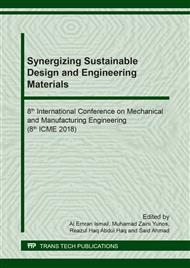[1]
A.B. Morgan, & J.W. Gilman. An overview of flame retardancy of polymeric materials: application, technology, and future directions. Fire and Materials. 37(4) (2013) 259–279.
DOI: 10.1002/fam.2128
Google Scholar
[2]
P.L. Dulebová,, J.E. Tomasz & D. Ing. Branislav. (2016). Properties and application of polymer - clay nanocomposites.
Google Scholar
[3]
Y. Dong, J. Jow & S. Lai. (2015). Fly Ash based Fillers and Flame Retardants. 2015 World of Coal Ash Conference in Nasvhille.
Google Scholar
[4]
A. Gharehbagh & Z. Ahmadi. (2012)., Polyurethane Flexible Foam Fire Behavior.
DOI: 10.5772/47965
Google Scholar
[5]
J.O. Akindoyo, et al. (ACAA), A. C. A. A. (2016) Coal Combustion Product (CCP) Production & Use Survey Report.
Google Scholar
[6]
A. Kausar et al. Recent Developments in Different Types of Flame Retardants and Effect on Fire Retardancy of Epoxy Composite. Polymer - Plastics Technology and Engineering, 55(14) (2016) 1512–1535.
DOI: 10.1080/03602559.2016.1163607
Google Scholar
[7]
M. Rakotomalala, S. Wagner & M. Döring. Recent developments in halogen free flame retardants for epoxy resins for electrical and electronic applications. Materials, 3(8) (2010) 4300–4327.
DOI: 10.3390/ma3084300
Google Scholar
[8]
R. Rothon & P. Hornsby. (2014). Fire Retardant Fillers for Polymers. In Polymer Green Flame Retardants.
DOI: 10.1016/b978-0-444-53808-6.00009-3
Google Scholar
[9]
A.B. Morgan & C.A. Wilkie (Eds.). (2007). Flame Retardant Polymer Nanocomposites. Hoboken, NJ, USA: John Wiley & Sons, Inc.
Google Scholar
[10]
K.M. Holder, R.J. Smith & J.C. Grunlan. A review of flame retardant nanocoatings prepared using layer-by-layer assembly of polyelectrolytes. Journal of Materials Science. 52(22) (2017) 12923–12959.
DOI: 10.1007/s10853-017-1390-1
Google Scholar
[11]
P. Kiliaris & C.D. Papaspyrides (2014). Polymers on Fire. Polymer Green Flame Retardants. Elsevier B.V.
DOI: 10.1016/b978-0-444-53808-6.00001-9
Google Scholar
[12]
A.B. Morgan & C.A. Wilkie Eds. (2007) Flame Retardant Polymer Nanocomposites. Hoboken, NJ, USA: John Wiley & Sons, Inc.
Google Scholar
[13]
S. Hörold, (2014). Phosphorus-based and Intumescent Flame Retardants. Polymer Green Flame Retardants.
DOI: 10.1016/b978-0-444-53808-6.00006-8
Google Scholar
[14]
S. Levchik, (2014). Phosphorus-based FRs. John Wiley & Sons. Retrieved from http://download.xuebalib.com/xuebalib.com.2581.pdf.
Google Scholar
[15]
S. Liang, N.M. Neisius & S. Gaan. (2013). Recent developments in flame retardant polymeric coatings. Progress in Organic Coatings, 76(11) (2013) 1642–1665.
DOI: 10.1016/j.porgcoat.2013.07.014
Google Scholar
[16]
K.M. Holder, R.J. Smith & J.C. Grunlan. A review of flame retardant nanocoatings prepared using layer-by-layer assembly of polyelectrolytes. Journal of Materials Science. 52(22) (2017) 12923–12959.
DOI: 10.1007/s10853-017-1390-1
Google Scholar
[17]
P. Kiliaris & C.D. Papaspyrides. Polymer/layered silicate (clay) nanocomposites: An overview of flame retardancy. Progress in Polymer Science (Oxford), 35(7) (2010) 902–958.
DOI: 10.1016/j.progpolymsci.2010.03.001
Google Scholar
[18]
G. You, Z. Cheng, H. Peng & H. He. The synthesis and characterization of a novel phosphorus-nitrogen containing flame retardant and its application in epoxy resins. Journal of Applied Polymer Science, 131(22) (2014) n/a-n/a.
DOI: 10.1002/app.41079
Google Scholar
[19]
E.D. Weil & V. Choudhary. Flame-Retarding Plastics and Elastomers with Melamine. Journal of Fire Sciences, 13(2) (1995) 104–126.
DOI: 10.1177/073490419501300202
Google Scholar
[20]
C.E. Wilén & R. Pfaendner. Design and Utilization of Nitrogen Containing Flame Retardants Based on N-Alkoxyamines, Azoalkanes and Related Compounds. In Polymer Green Flame Retardants, 1st edtion, Elsevier. (2014) 267–288.
DOI: 10.1016/b978-0-444-53808-6.00008-1
Google Scholar
[21]
Z.T. Yao et al. A comprehensive review on the applications of coal fly ash. Earth-Science Reviews, 141 (2015) 105–121.
Google Scholar
[22]
A. Chaipanich, T. Nochaiya, W.T.P. Wongkeo. Mater Sci Eng A (527) (2010)1063.
Google Scholar
[23]
S.R. Rama & S.K. Rai. Mechanical and Fractrographic Studies on Fly ash-filled Hydroxyl-terminated Polyurethane-toughened Epoxy Composites. Journal of Composite Materials, 43(26) (2009) 3231–3238.
DOI: 10.1177/0021998309345331
Google Scholar
[24]
N.A.N. Alkadasi, D.G. Hundiwale & U.R. Kapadi. Polyurethane types, synthesis and applications – a review. RSC Adv., 6(115), 114453–114482., Effect of coupling agent on the mechanical properties of fly ash-filled polybutadiene rubber. Journal of Applied Polymer Science, 91(2) (2004) 1322–1328.
DOI: 10.1002/app.13280
Google Scholar
[25]
A.H. Kang et al. Rejuvenated fly ash in poly (vinyl alcohol)-based composite aerogels with high fire safety and smoke suppression. Chemical Engineering Journal. 327 (2017) 992–999.
DOI: 10.1016/j.cej.2017.06.158
Google Scholar
[26]
M. Soyama, K. Inoue & M. Iji. Flame retardancy of polycarbonate enhanced by adding fly ash. Polymers for Advanced Technologies, 18(5) (2007) 386–391.
DOI: 10.1002/pat.900
Google Scholar
[27]
A.R. Tarakcılar. The effects of intumescent flame retardant including ammonium polyphosphate/pentaerythritol and fly ash fillers on the physicomechanical properties of rigid polyurethane foams. Journal of Applied Polymer Science. 120(4) (2011) 2095–2102.
DOI: 10.1002/app.33377
Google Scholar
[28]
Q. Tai, et al. A novel polymeric flame retardant and exfoliated clay nanocomposites: Preparation and properties. Chemical Engineering Journal. 183 (2012) 542–549.
DOI: 10.1016/j.cej.2011.12.095
Google Scholar
[29]
J.H. Chang and U.A. Yeong. Nanocomposites of polyurethane with various organoclays: thermomechanical properties, morphology, and gas permeability. J Polym Sci Part B Polym Phys. 40 (7) (2002) 670–677.
DOI: 10.1002/polb.10124
Google Scholar
[30]
M. Tortora et al. Structural characterization and transport properties of organically modified montmorillonite/ polyurethane nanocomposites. Polymer. 43(23) (2002) 6147–6157.
DOI: 10.1016/s0032-3861(02)00556-6
Google Scholar
[31]
X. Zheng, G. Wang, G, W. Xu, W. Roles of organically-modified montmorillonite and phosphorous flame retardant during the combustion of rigid polyurethane foam. Polymer Degradation and Stability. 101 (2014) 32–39.
DOI: 10.1016/j.polymdegradstab.2014.01.015
Google Scholar
[32]
P. Pandey, S. Mohanty & S.K. Nayak. Improved flame retardancy and thermal stability of polymer/clay nanocomposites, with the incorporation of multiwalled carbon nanotube as secondary filler: evaluation of hybrid effect of nanofillers. High Performance Polymers, 26(7) (2014) 826–836.
DOI: 10.1177/0954008314531802
Google Scholar


